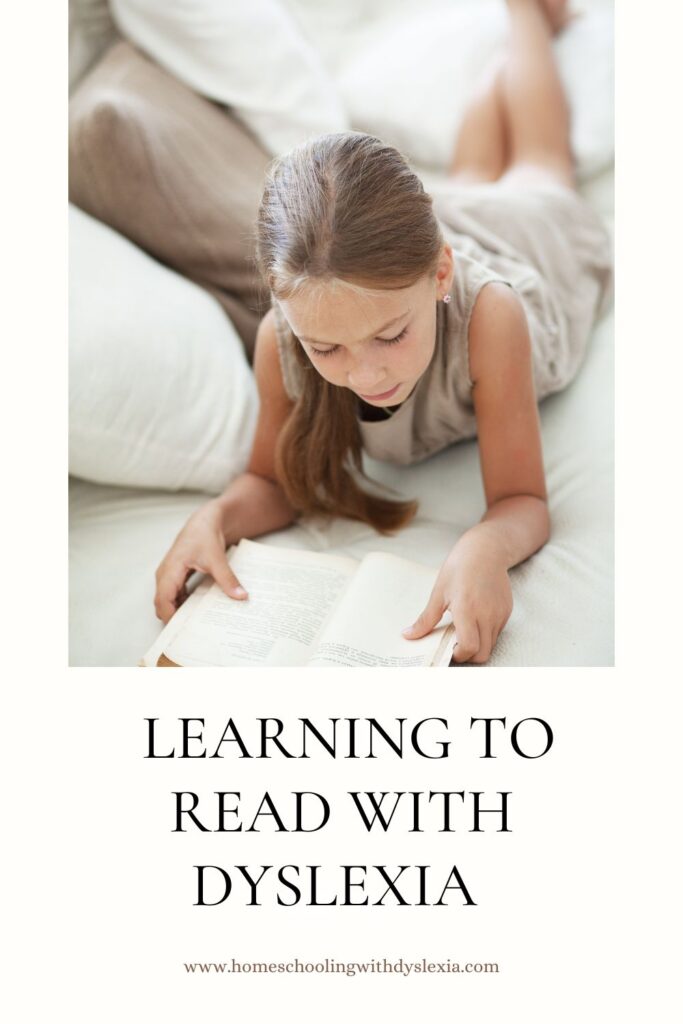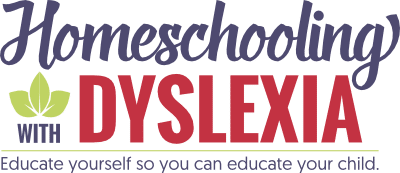I talk to SO many parents who are concerned, confused, worried, and overwhelmed about the lack of progress their kids with dyslexia are having learning to read and spell.
I totally get it! Although all of my kids are reading now, there were many years where I struggled with these same feelings.
If you would prefer to listen to this post, click the player below:
This post is meant to help you understand what a normal learning trajectory for learning to read and spell is for a child with dyslexia. Having the right mindset and expectations about this will help you avoid wasting a lot of time and energy looking for other programs or thinking about putting your kids in school as well as improve your overall homeschool experience with your kids.
How to Teach Reading and Spelling to Kids with Dyslexia
Any discussion about teaching reading and spelling to kids with dyslexia has to start with the right foundation. There are hundreds of reading programs available today but most are not effective for kids with dyslexia.
What is dyslexia?
Dyslexia is a language-based learning difficulty; sometimes referred to as a disability.
For a better understand of this terminology, see this post, What is the Difference Between Learning Differences and Learning Disabilities, from Shawna Wingert at Different by Design Learning.
A child with dyslexia will have unexpected difficulty with mastering the written word. This struggle is unexpected because the child is smart and has had adequate instruction; instruction that would normally ‘work’.
It might be good to state here that the only reason for a child with at least average intelligence to struggle learning to read is either a massive lack of opportunity (as seen in situations of extreme child abuse), poor hearing or sight, or dyslexia.
If you’re reading this post today, your child does not have a lack of opportunity.
Language-based learning difficulties make learning language (reading, spelling, and writing) extremely difficult. If you’ve been teaching your child for more than a week you already know this.
Before we talk about what it looks like to teach kids with dyslexia to read and spell, we need to assume that you are using a method that is effective.
Research shows that the most effective method or approach to teaching reading is the Orton-Gillingham approach.
What is the Orton Gillingham (O-G) Approach to Teaching Reading?
Evidence-based research has shown that using O-G for individuals with dyslexia (children and adults) will actually restructure their brains to help them learn to read and spell more efficiently.
Hallmarks of OG-based reading program is:
- Explicit
- Systematic & Structured
- Sequential & Cumulative
- Multi-sensory
- Individualized
- Diagnostic & Prescriptive
If you’re new to the world of dyslexia and reading instruction, read these posts about Orton-Gillingham:
What is the Orton-Gillingham Approach to Teaching Reading? A detailed explanation of the OG approach.
A Comparison of the Top Four Orton-Gillingham Reading Programs for Homeschool A detailed comparison of OG programs designed for use by parents at home.
Teaching Reading With Dyslexia in the Elementary Years
So now that we have defined our terms, namely dyslexia and Orton-Gillingham, let’s look at what learning to read with dyslexia really looks like.
I recently wrote about what learning in general looks like for an elementary-aged child with dyslexia. Because of the delay in reading, spelling, and writing fluency, day-to-day learning is going to look a LOT different.
And that is OKAY!
Things that are normal to see while your child with dyslexia is learning to read and spell:
- Difficulty remembering sounds and rules
- Remembering a rule or concept one day and forgetting the next
- Difficulty with handwriting
- Difficulty with expression; finding the right word
- Resistance to reading instruction
For a complete list of signs of dyslexia, read this.
Things that are normal to feel when your child is struggling to learn:
Feeling like you’re not doing enough, but lacking the time and resources to actually DO more. First of all, most homeschool families feel like this at times so it’s normal to feel this way. It’s all about priorities.
Feeling alone or like no one else understands what you’re experiencing. Finding a support group of some kind is super helpful for walking out the day-to-day. Here’s a post on how to find support groups near you.
Feeling guilty for taking a break from teaching. The truth is you could be trying a research-based strategy that should help but isn’t for one reason or another. The truth is that you NEED a break. It’s okay to stop banging a square peg into a round whole and find a different strategy.
Kids with dyslexia learn to read, write, and spell LATER and at all different times. There is no ‘benchmark’ for a dyslexic child learning to read.
There is a wide range of normal with kids with dyslexia depending on whether their dyslexia is mild, moderate, or profound. You can read more about degrees of dyslexia and how to teach a child with profound dyslexia here.
Worried about their future. This is also common to many parents whether their kids have learning differences or not. Here’s what I know…teach your kids at their level with reasonable consistency, modify curriculum to meet their real needs, accommodate with assistive technology when helpful, and help them find something that they like and are good at – whether that means college, trade school, work experience, or starting their own business. All of my adult kids with dyslexia have found success with this ‘formula’.
So with this understanding, what do we actually do each day?
I always recommend to do some kind of remediation with kids with dyslexia. Remediation is simply strengthening the foundation for reading. So, OG lessons a minimum of three days per week if you can.
It’s okay to take breaks when you need them. Kids with dyslexia have good days and bad days and so do their parents! Taking a break is not a reason to feel guilty. It’s being in tune with the real needs of your family and can often result in breakthroughs and more productive learning.
Be creative. If a teaching strategy isn’t working or you notice something that actually made things click for your child, feel free to change things up and modify what you’re doing to best meet their needs.
Prioritize relationships. Adhering to a strict schedule or standard at the expense of your relationship with your child is generally not a good idea. None of us are perfect with this. We all let our to-do lists trump real life at times. However, if you’re using all the modifications and accommodations you know of and there is tension and resistance, opt to take a break (at least for a time) over engaging in a power struggle with your child.
See this post on how and when to take some time to ‘deschool’.
Outsource if necessary. Sometimes circumstances are such that there isn’t enough time to be consistent with teaching reading or the tension from teaching is causing too much strain on your relationship with your child. Hiring a tutor can be HUGE relief to both parent and child.
Read this post on How and When to Hire a Dyslexia Tutor and this one, How to Find Free or Inexpensive Dyslexia Tutoring for help in this area.
Key Takeaways
A few key takeaways from this post are:
1. It is NORMAL for kids with dyslexia to learn at a completely different time frame than traditional learners. You could do all the ‘right’ things and your child still may learn to read independently when they are 12-14.
2. Knowing that, we can (and should) adjust our expectations. Read this post on Mindset Shifts for Parents of Struggling Learners to learn the 4 mindset shifts that made the biggest impact on our homeschool.
So if you are a parent of an 8-12 year old who is not reading fluently or independently, don’t panic! Also, you are not alone.
See this Facebook thread to see when other family’s kids with dyslexia learned to read.
Keep doing what is the next best thing for you and your child. In my 25+ years of teaching kids with dyslexia, I can confidently say that this is more than enough. It’s the best approach to teaching outside-the-box learners.
Support for Homeschooling Kids With Dyslexia (and ADHD)
Last summer I ran some small coaching groups to share what I consider to be the most important things parents need to know about homeschooling and education in general when it comes to kids who learn differently. The content of my teaching was essentially the questions that I receive all the time from parents in the trenches like you!
Since the response was so great, I recorded all of the sessions so that anyone can get access to the materials whenever they want without needing to meet in person.
There are three versions of the Homeschool Essentials Courses:

You can learn more about the Homeschool Essentials Course here.
Purchase here:
Elementary Homeschool Essentials
Middle School Homeschool Essentials
High School Homeschool Essentials
Save more by purchasing all 3 Homeschool Essentials Courses






Hello,
I appreciate being educated about dyslexia. I find benefit from learning about dyslexia to teach my developmentally delayed son. However, do you know of any blogs specifically about teaching children who are developmentally delayed/ diagnosed with intellectual disabilities?
I appreciate it.
Hi Maryam,
I don’t know of any but HSLDA has some good info:
https://hslda.org/teaching-my-kids/special-needs
Hello,
I appreciate learning from your work about dyslexia! Do you know of any blogs or resources specifically for homeschooling kids with intellectual disability?
Thank you,
Maryam